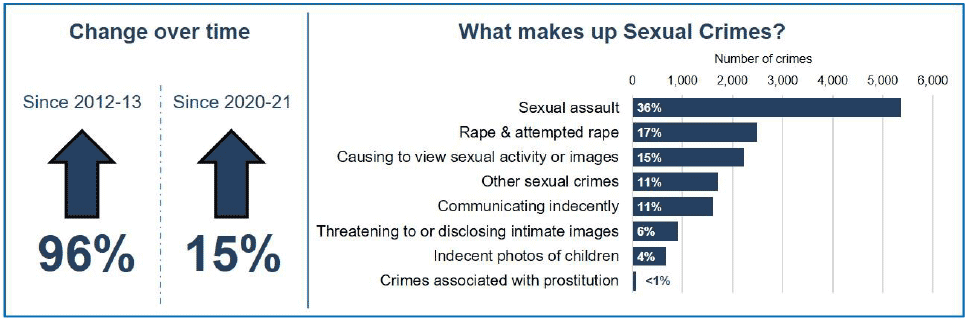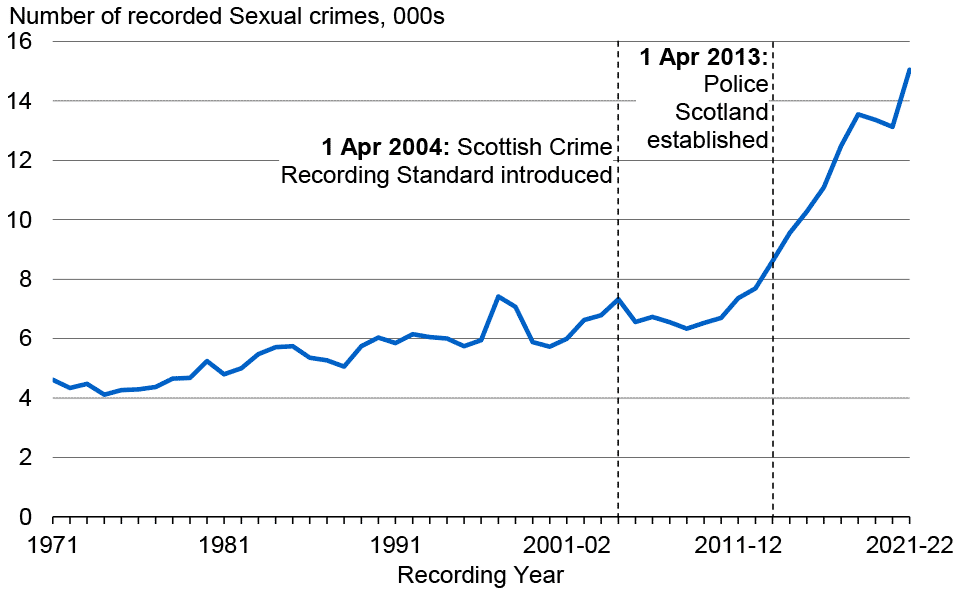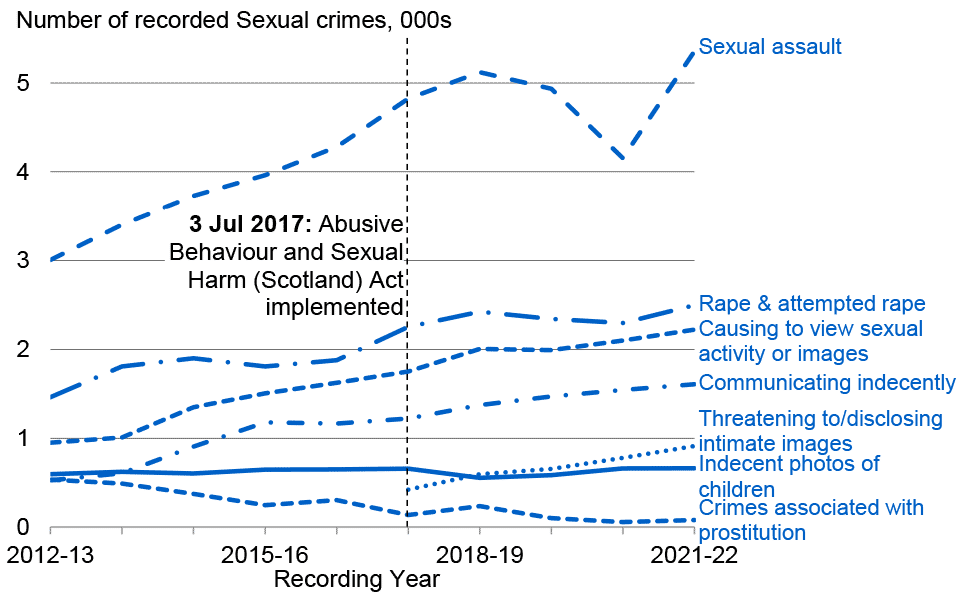Recorded Crime in Scotland, 2021-2022
Statistics on crimes and offences recorded and cleared up by the police in Scotland in 2021-22, split by crime or offence group and by local authority.
Sexual Crimes

The only impact on Sexual crimes of the new grouping structure used in this bulletin is the introduction of more detailed categories. This includes the splitting of the previous Other sexual crimes category into the five new categories of:
- Causing to view sexual activity or images
- Communicating indecently
- Threatening to or disclosing intimate images
- Indecent photos of children
- Other sexual crimes
Sexual crimes account for 5% of all crimes recorded in Scotland in 2021-22. The number of Sexual crimes recorded by the police in Scotland increased by 15% from 13,131 in 2020-21 to 15,049 in 2021-22.
Chart 7 below shows the number of Sexual crimes from 1971 onwards. Sexual crimes have been on a long-term upward trend since 1974, with some fluctuations. Prior to small decreases in 2019-20 and 2020-21, there had been increases each year since 2008-09.
The national rate of recorded Sexual crimes was 28 crimes per 10,000 population in 2021-22, up from 24 per 10,000 population in 2020-21.
A number of legislative and procedural changes should be kept in mind when reviewing trends in Sexual crimes over the longer term. These are presented in Annex 3.
In addition to these changes, the issue of historical reporting of sexual crime also continues to play a role in the latest statistics. Further information from Police Scotland suggests that just under a quarter (23%) of Sexual crimes in 2021-22 were recorded at least one year after they occurred. This figure is similar to the previous year. Furthermore, as discussed below, the use of specific codes to record sexual crime also highlights where these cases are historical.
There were 878 crimes of Lewd and libidinous practices in 2021-22. These crimes should all relate to offences which occurred prior to the implementation of the Sexual Offences (Scotland) Act 2009 on 1 December 2010, as the Act replaced Lewd and libidinous practices with specific sexual assault crimes. As a result, we know that these are historical (non-recent) offences. Similarly, there were 203 crimes of Sexual assault committed prior to 1 December 2010.
The increase in sexual cyber-crimes has also had an impact on the trend of recorded Sexual crimes in recent years. We estimate that the volume of Sexual crimes that were cyber-crimes has increased from 1,100 in 2013-14[3] to 4,210 in 2021-22 (further information on this is available in the Cyber-crime chapter).

The specific age of the victim cannot generally be determined from the data supplied by Police Scotland. However, many of the sexual crime codes used by the police to record crime are based on specific age groupings in line with the legislation (for example, Sexual assault of older male child (13-15 years)). This will include where the perpetrator targets someone they believed to be a child (for example, through cyber-enabled sexual crime). By adding up all these crime codes, we know that at least 37% of the 15,049 Sexual crimes recorded in 2021-22 by the police related to a victim under the age of 18. This proportion is similar to recent years.
Chart 8 shows the categories within Sexual crimes over the last ten years, and gives an indication of the trend and scale of each category.

In 2021-22, of all Sexual crimes:
- Sexual assault accounted for 36%
- Rape & attempted rape accounted for 17%
- Causing to view sexual activity or images accounted for 15%
- Other sexual crimes and Communicating indecently accounted for 11% each
- Threatening to or disclosing intimate images accounted for 6%
- Indecent photos of children accounted for 4%
- Crimes associated with prostitution accounted for less than 1%
It should be noted for data prior to 2010-11 that the implementation of the Sexual Offences (Scotland) Act 2009 had an impact on the recording of crimes in this group. Further information on this change is available in Annex 3.
Table A1 in the 'Supporting documents' Excel workbook contains more detailed breakdowns for Sexual crimes.
The following sections discuss trends for each crime category comprised in the Sexual crimes group. These are:
- Sexual crimes
- Rape & attempted rape
- Sexual assault
- Causing to view sexual activity or images
- Communicating indecently
- Threatening to or disclosing intimate images
- Indecent photos of children
- Crimes associated with prostitution
- Other sexual crimes
Rape & attempted rape
Rape & attempted rape accounted for 17% of Sexual crimes. After an upward trend from 2012-13 to 2018-19, there has been decreases in both 2019-20 and 2020-21. However, there was a 9% increase in the most recent year, from 2,298 crimes in 2020-21 to 2,498 in 2021-22.
Sexual assault
Sexual assault accounted for 36% of Sexual crimes. After an upwards trend from 2012-13 to 2018-19, there have been decreases in both 2019-20 and 2020-21. However, there was a 29% increase in the most recent year, from 4,154 crimes in 2020-21 to 5,359 in 2021-22.
Causing to view sexual activity or images
Causing to view sexual activity or images accounted for 15% of Sexual crimes. After an upwards trend from 2012-13 to 2018-19, these has been some fluctuation in 2019-20 and 2020-21. There was a 6% increase in the most recent year, from 2,101 crimes in 2020-21 to 2,223 in 2021-22.
Communicating indecently
Communicating indecently accounted for 11% of Sexual crimes. These crimes have seen an upwards trend over the last decade. There was a 4% increase in the most recent year, from 1,543 crimes in 2020-21 to 1,608 in 2021-22.
Threatening to or disclosing intimate images
Threatening to or disclosing intimate images accounted for 6% of Sexual crimes. This category includes crimes being recorded under the Abusive Behaviour and Sexual Harm (Scotland) Act 2016, which was implemented on 3 July 2017. Since then, these crimes have seen an upwards trend. There was a 17% increase in the most recent year, from 780 crimes in 2020-21 to 912 in 2021-22.
Indecent photos of children
Indecent photos of children accounted for 4% of Sexual crimes. These crimes have seen some fluctuation over the last decade. The number of crimes recorded has remained broadly stable in the most recent year, with 660 in 2020-21 and 662 in 2021-22.
Crimes associated with prostitution
Crimes associated with prostitution accounted for a very small proportion of Sexual crimes, at less than 1%. Over the ten year period from 2012-13 to 2021-22, these crimes have seen a large fall of 85%. There has been an increase in the most recent year, from 56 crimes recorded in 2020-21 to 80 in 2021-22 (43% increase).
Almost a third (31%) of the crimes recorded in 2021-22 were in the Glasgow City area, with a further 24% recorded in Aberdeen City.
Other sexual crimes
Other sexual crimes accounted for 11% of Sexual crimes.
The Other sexual crimes category includes a wide range of crime types. The largest by volume in 2021-22 was Voyeurism[4], accounting for just under a third (32%) of all crimes recorded in the Other sexual crimes category in 2021-22 (547 crimes). More detail on the crimes included is provided in the 'Supporting documents' Excel workbook and in the User Guide.
This category has been on an upward trend for some time, with crimes increasing from 618 in 2012-13 to 1,707 in 2021-22 (up 176%). This also includes an 11% increase in the most recent year, from 1,539 crimes recorded in 2020-21 to 1,707 in 2021-22.
The sections below include information that should be considered to widen contextual understanding of the data provided on Sexual crimes. Detail is provided on limited comparisons with recorded crime in England & Wales and Northern Ireland. Further detail on the type of information available from the SCJS on sexual crime is also included.
Data comparisons: Recorded Crime in England & Wales and Northern Ireland
While recorded crime in Scotland is not directly comparable with England & Wales or Northern Ireland due to differences in legislation and counting rules, there are some signs of increases in police recorded sexual crimes across the UK in recent years[5]. This reflects a number of factors, including the impact of high-profile incidents, media coverage and campaigns on people’s willingness to report incidents to the police, as well as a potential increase in the number of victims. Similarly, sexual offences have shown an upwards trend in Northern Ireland[6], with the most recent quarter (Jan-Mar 2022) showing the highest quarterly figure over the last ten years.
Data comparisons: Self-completion modules in the Scottish Crime and Justice Survey (SCJS)
Detailed information on the victims of sexual crime is not collected in the main Scottish Crime and Justice Survey (SCJS). Information on sensitive topics is collected through a number of additional self-completion sections. Some of these sections include information on sexual crime. For example, the self-completion elements of the 2018-19 and 2019-20 surveys included questions on sexual victimisation, stalking and harassment, and partner abuse. The survey found that in 2018-20:
- there have been some increases in the proportion of adults experiencing certain types of sexual victimisation since 2008-09
- almost one-in-eight adults (11.8%) experienced at least one type of stalking and harassment
- 16.5% of adults said they had experienced at least one incident of partner abuse since the age of 16, but these have decreased since 2008-09
The findings are included in the 2019-20 SCJS Main Findings report.
Contact
Email: Justice_Analysts@gov.scot
There is a problem
Thanks for your feedback